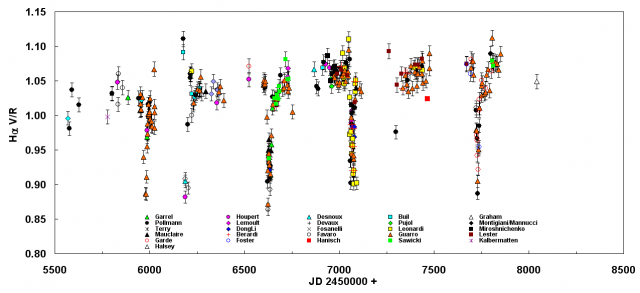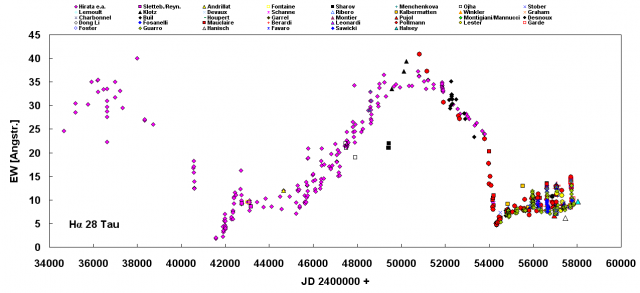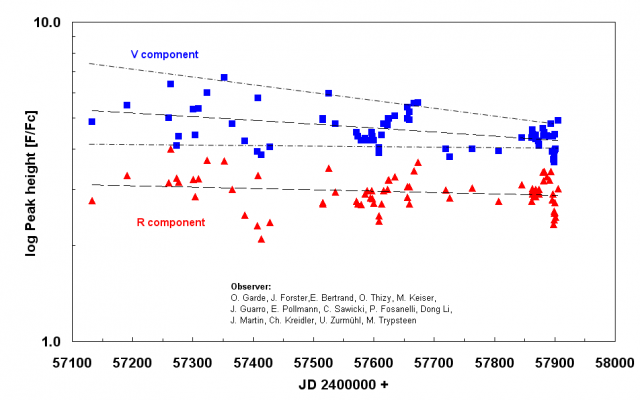Forum Replies Created
-
AuthorPosts
-
 Ernst PollmannParticipant
Ernst PollmannParticipantDear colleagues,
I would like to inform you about the updated conference program of the Spectroscopy Conference VEGA 2019.
See:http://www.astrophoto.at/VEGA/index.html
Best wishes,
Ernst Pollmann Ernst PollmannParticipant
Ernst PollmannParticipantDear colleagues,
herewith I would like to inform about the current state of the Halpha campaign results, See:
http://www.spectro-aras.com/forum/viewtopic.php?f=19&t=1813&p=9748#p9748
Best wishes, Ernst Pollmann
 Ernst PollmannParticipant
Ernst PollmannParticipantHi Alun,
here comes the evaluation of your 2400 L/mm spectrum.
The ARAS monitoring, covers the radial velocity, äquivalent width and the V/R ratio of the Halpha emission.
As you can see, all values of your spectrum fits perfect in the current monitorings. It would be great, when you could continue your observation of that star.
If you are interested in results gotten by the ARAS community in the past, I recommend the study of the IBVS paper at:
http://astrospectroscopy.de/media/files/Periastron_-28-Tau_englisch.pdf


Ernst
 Ernst PollmannParticipant
Ernst PollmannParticipantHi Alun,
a 1D profile would be fine.
Ernst
 Ernst PollmannParticipant
Ernst PollmannParticipantHi Alun,
I am interested in your both spectra of 28 Tau for the ARAS long-term monitoring of the radial velocity, Halpha V/R and Halpha EW.
Would you be so friendly to send me your fits files?Best wishes,
Ernst Ernst PollmannParticipant
Ernst PollmannParticipantDear colleagues,
if you wants to be informed about the current Halpha observation state of the campaign, here the corresponding link:
http://www.spectro-aras.com/forum/viewtopic.php?f=19&p=9412#p9412Ernst Pollmann
 Ernst PollmannParticipant
Ernst PollmannParticipantHugh,
you wrote: I’ve read contradictory remarks on that.
Would you be so friendly, to give information corresponding to that more in detail?Ernst
 Ernst PollmannParticipant
Ernst PollmannParticipantHi Tony and Hugh,
I am just back from the OHP meeting and saw your postings concerning low resolution spectra of VV Cep in the visible spectral range. In principle such a spectra does have also a certain scientific value, no question. In general they could reflect certain flux variations caused by variable mass flow from the super giant to the accretion disk.
But to detect this in the visible spectral range, a very precisely instrumental correction is required. In such a way corrected spectra, should show during the eclipse small continuum variation caused of the mass flow variation of the M star wind.
But again: instrumental correction is here very important.
In addition it should be also possible to detect, the disappearance of the B star (not Be) during the eclipse and its appearance after this event. On the other hand, the more important observations period at present is the eclipse itself and the expected eclipsing-time difference of the blue and red component (not the wings as you said) of Halpha. This is more precisely to detect in high resoluted spectra, taken with the LHIRES and 2400 L/mm grating. If you can do that, please upload your spectra at the BAA data base. That is the more comfortable way.Ernst
 Ernst PollmannParticipant
Ernst PollmannParticipantDear colleagues,
please don´t forget to observe VV Cep.
It is not exclude that the eclipse could begin some days before the calculated date August 4th.Ernst
 Ernst PollmannParticipant
Ernst PollmannParticipantA revision of the analysis of the previous campaign spectra has now led to the use of the equivalent width (EW) of the red and blue components for the determination of the baseline.
See: http://www.bav-astro.eu/index.php/veraenderliche/bedeckungsveraenderliche/vv-cep-kampagneTo translate the German text use the Google-translater.
In view of the immediate imminent eclipse, a well-defined base line now appears for both, the peak height and the EW. At the upcoming OHP spectroscopy session in the last week of July, we will try to improve the quality of the baselines by further observations.
Ernst Pollmann
 Ernst PollmannParticipant
Ernst PollmannParticipantNews of VV Cep > see:
http://www.spectro-aras.com/forum/viewtopic.php?f=19&t=1713&p=8445#p8445
Ernst
 Ernst PollmannParticipant
Ernst PollmannParticipantI would like to invite everyone to report about observation results or spectroscopic experiments in that new magazine.
Submitted articles are checked by a team of referees.
Ernst
 Ernst PollmannParticipant
Ernst PollmannParticipantDear colleagues,
Jack Martin sent me a lot of spectra which did fill some gaps of the year 2015 and 2016 (see the attached monitoring). As we can see, the variability of the peak height of the V component becomes more and more smaller the more the moment of the eclipse is approaching.
I think that in the current phase (shortly before the eclipse and in the line of sight) the large and expanded Halpha emission-forming area (where the scattering will be produced) more and more is diving into the semi-transparent atmosphere of the M supergiant, and therefore the divergence of the peak height variability becomes smaller and smaller.
The divergence should become almost zero (ideal) and the peak height should remain stable, if the moment of the eclipse is reached.

Ernst Pollmann
 Ernst PollmannParticipant
Ernst PollmannParticipantHi Marc & Robin,
the observer group (see attachment) is going to continue their HR observation of the V&R component in order to catch the moment of the beginning of its eclipse. It seems that the peak height of the V component decreases already “for some time”.
If this “effect” is true, then that does it mean, either the disk of the B star or the photospheric wind of the M star (or both) is larger than assumed until now. But we have to wait and see. In that context I am interested to get your spectrum. Would you be so friendly to send me it?

Best wishes, Ernst
 Ernst PollmannParticipant
Ernst PollmannParticipantDear Paul,
that’s a fantastic example in order to use it in my regular spectroscopic seminars at the University of the city of Wuppertal here. Mostly seminars for beginners. Is it possible to get the fits file?
I would like to scan the sky and the spectrum separately in order to show the emissions of the sky within the spectra itself and how important the subtraction is.Best wishes, Ernst
 Ernst PollmannParticipant
Ernst PollmannParticipantFor those, who have difficulties to imagine the process of disk-nodding and disk-precession in zeta Tau, here a link to an animation:
http://astrospectroscopy.de/media/files/disk-nodding_slow.AVI
Arranged from: Schaefer et al., The astron. Journal, 140, 1838-1849, 2010
Ernst Pollmann
 Ernst PollmannParticipant
Ernst PollmannParticipantDear colleagues, thanks again for your warm welcome. It’s a nice feeling to get this.
Ernst
 Ernst PollmannParticipant
Ernst PollmannParticipantJack, I have evaluated your 2015-09-10 spectrum. Please have a look at the Spectro-L Yahoo-List. I think also it would be at present more important to get a reliable base line, because we are in the “hot phase on the way” to the eclipse.

Ernst
 Ernst PollmannParticipant
Ernst PollmannParticipantAs far as I am informed, are there no investigation in that direction, Marc.
Ernst
 Ernst PollmannParticipant
Ernst PollmannParticipantHi Marc, actually the Halpha V&R and V/R are high variable parameters with a certain periodic behavior. Please have a look to the investigation we recently published at IBVS No. 6156
http://astrospectroscopy.de/media/files/IBVS_6156-02.pdf
The source of the variability of Halpha, originating from an accretion region around the hot companion, remains unclear and the time sampling of these Halpha observations are too sparse to permit a meaningful period analysis. See our IBVS publication No. 6198:
http://ibvs.konkoly.hu/pub/ibvs/6101/6198.pdf
Best wishes, Ernst
-
AuthorPosts
